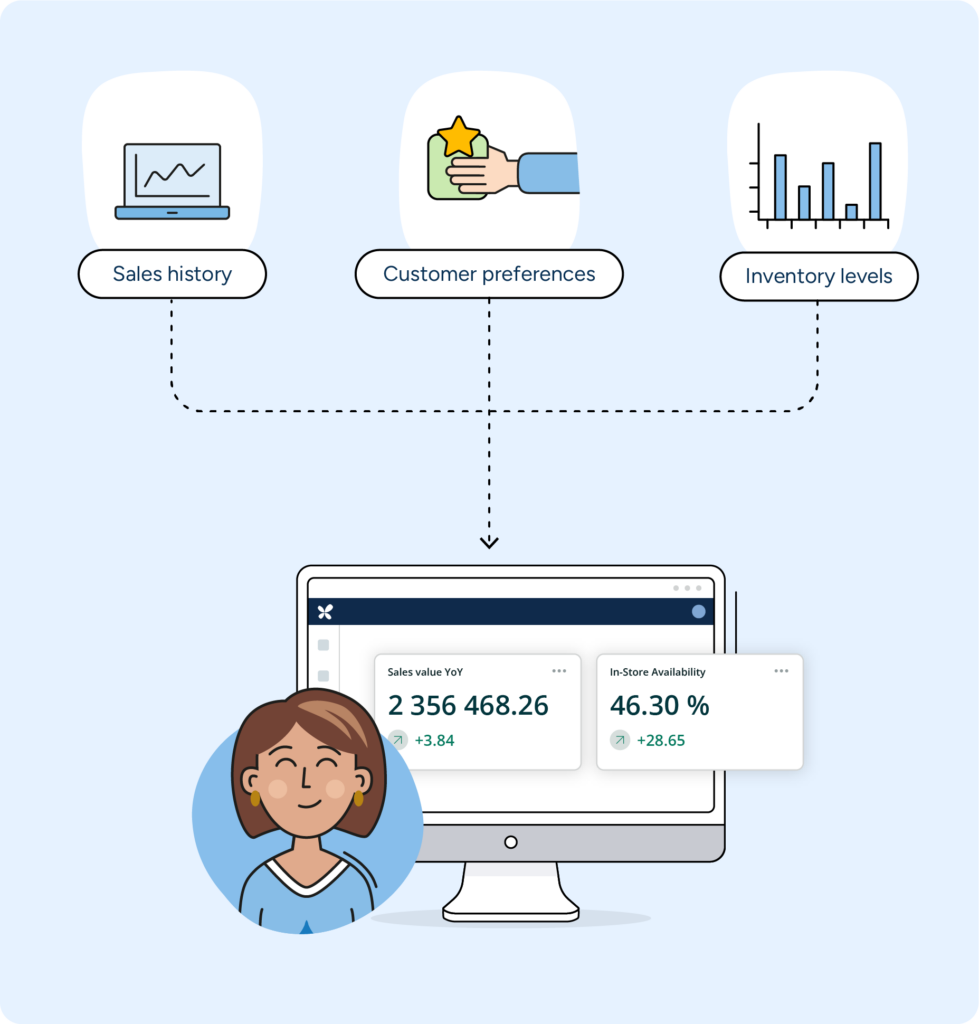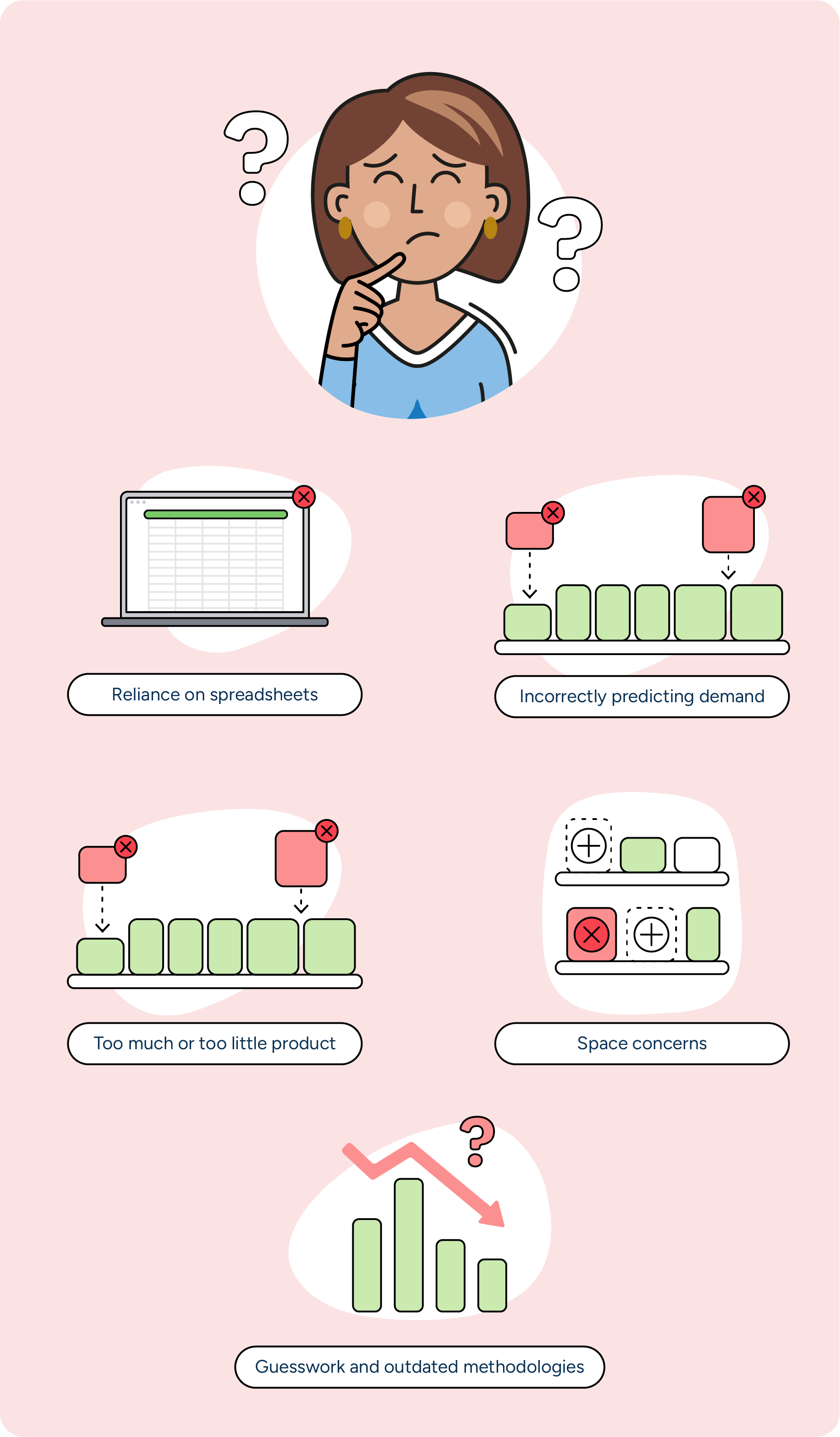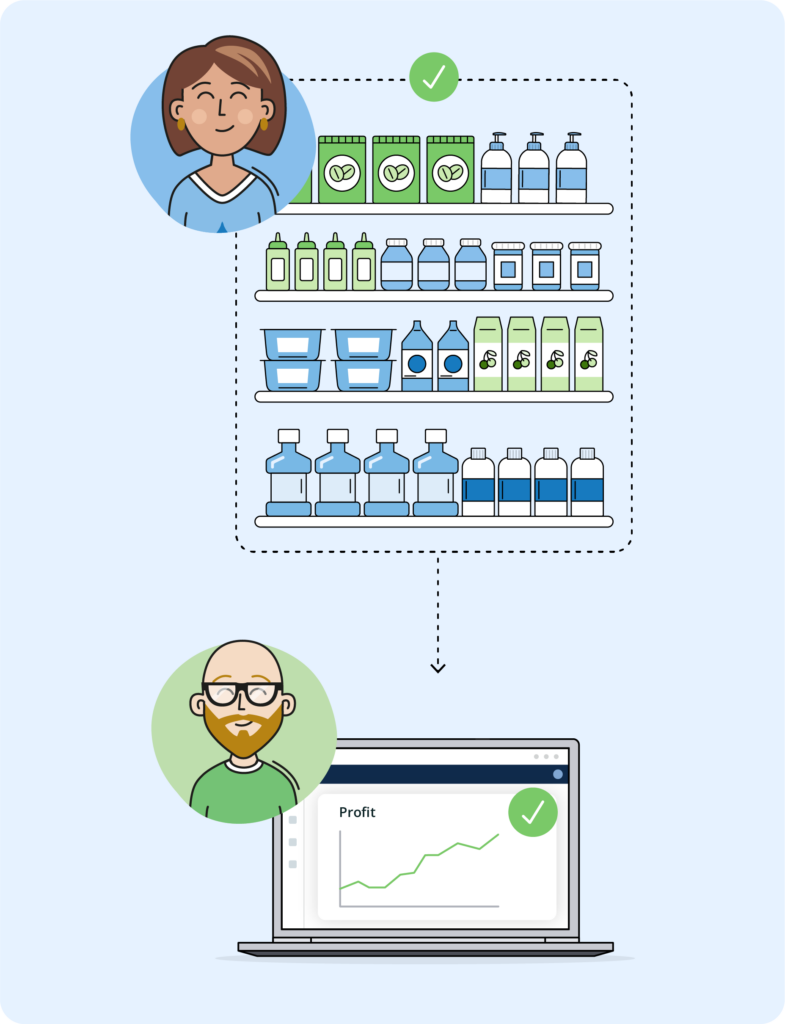What is assortment planning? Navigating the complexities
Jun 6, 2024 • 10 min
Assortment planning is a game-changer for retailers when it comes to boosting sales and revenue, and here’s why: Imagine walking into a store and finding the exact product you’ve been looking for, maybe even something you didn’t know you needed until you saw it. That’s no accident. Retailers use assortment planning to ensure they stock up on the products that people really need and want, especially the hot items that fly off the shelves.
By carefully selecting a mix of products that cater to customer needs, desires, and trends, stores can see a significant uptick in sales. It’s not just about having a variety of items; it’s about having the right ones and those that resonate with shoppers. Customers can then buy more and even explore products they hadn’t considered before, leading to higher transaction volumes.
Retailers can turn casual browsers into loyal buyers, making the cash register ring more often. It’s a win-win: customers get what they want, and stores see their revenue climb.
What is assortment planning?
Assortment planning is how retailers determine the right mix of items to sell. It considers seasonal demand and customer preferences while determining how different assortments look in different stores.
By carefully selecting which products to carry, retailers can cater to their target market’s preferences, driving customer satisfaction and loyalty. Aligning product offerings with customer demand is crucial, directly impacting sales and inventory efficiency.
Introducing market basket analysis enriches this process, allowing managers to discern patterns in product purchases and optimize inventory with even greater accuracy. This strategic use of MBA in assortment planning ensures the right products are always available, enhancing customer satisfaction and driving sales.
Category managers must analyze market trends, sales data, and customer feedback to make informed decisions about which products to include in their assortment. This process ensures that retailers offer products that customers want while also hitting financial targets and aligning with strategic objectives.
The rise of omnichannel retailing, where customers expect a seamless shopping experience across online and offline channels, has significantly impacted assortment planning. Retailers must now consider how their product mix will be presented and sold across different channels, ensuring consistency and accessibility.
Omnichannel retailing demands a more dynamic and flexible approach to planning as retailers strive to meet customer expectations wherever they choose to shop.
The benefits of optimized assortment planning
Creating optimized assortments is a crucial strategy for retailers, bringing benefits that boost business performance and customer happiness. This means the products customers really want are always in stock, leading directly to higher sales, more revenue, and an efficient supply chain.
Optimized assortments also:
Improve customer satisfaction
By carefully curating product assortments to align with customer needs and preferences, retailers can create an effortless shopping experience that meets and exceeds customer expectations, fostering customer loyalty and encouraging repeat business.
Reduce inventory costs
Retailers can reduce excess inventory by identifying and eliminating underperforming products, lowering carrying costs. This optimization frees up valuable capital that can be reinvested in more profitable items. Added shelf capacity on high-turn items can increase sales and customer satisfaction and reduce stockouts and store labor.

Enhance inventory turnover
Optimized assortment planning ensures that inventory moves more quickly through the supply chain, reducing the risk of stockouts or overstock situations. This leads to a healthier inventory turnover rate, which is crucial for maintaining cash flow and profitability.
Optimize the use of store space
By aligning product assortments with store layouts and space planning, retailers can better use their physical space, improving the shopping experience and maximizing sales per square foot.
Create localized assortments
Developing localized assortments enables retailers to meet the unique preferences and purchasing habits of various demographics, enhancing the shopping experience by adding a personal touch and potentially leading to increased sales.
The challenges and headaches of assortment planning
Why is assortment planning so tricky? For category managers using multiple solutions and relying on spreadsheets to manage data, it’s a very time-intensive process. A manager might have Excel, a company ERP, and a separate reporting tool. With separate tools comes the potential for having different data sources and clouding data integrity.
It’s difficult to make sound decisions without trust in your data. Working with multiple tools can result in data cleanliness issues and conflicting recommendations from different support teams, hindering strategic decision-making.
Collecting data in one place while ensuring it looks the same for everyone involved in the process can be difficult. Multiple planning managers might also be involved, each approaching the job in a slightly different way.

Additional challenges include:
Incorrectly predicting demand
Retailers and category managers can miss products that resonate with their customers, leading to unsold inventory, diminished sales, and customer satisfaction.
Too much or too little
Overstocking means your money is stuck in items that are not selling, and you’re paying more for storage. On the flip side, having insufficient stock means missing out on sales and leaving customers unhappy.
Lack of agility
The retail scene is constantly changing, and trends can shift quickly. Outdated product selections might not resonate with customers, putting retailers at a disadvantage against their more agile competitors.
Space concerns
Retailers must select products that ensure their displays attract customers and enhance the shopping experience. Using space inefficiently can negatively impact sales and replenishment as shelf space per product might be too little or too much, and incorrect amounts can impact ideal replenishment practices.
Guesswork and outdated methodologies
With optimized data, retailers can avoid relying on intuition or outdated practices, potentially overlooking emerging trends and customer preferences.
Traditional planning without optimized software
Can category managers navigate planning assortments without access to optimized assortment planning software? The answer is yes, but it will be time-consuming and tedious.
Without tools that incorporate AI and machine learning into planning, category managers will have to manually analyze historical sales data to identify patterns, seasonal preferences, and potential areas for expansion or reduction in their product lines while continuing to rely on suppliers for insights into upcoming product trends, exclusive deals, or new product lines.
Optimized assortment planning tools will aid category managers who previously only utilized manual techniques.
Assortment planning with advanced planning tools using AI and data opens a more efficient world to the category manager and is really a must-have in today’s world.
Assortment planners need optimized advanced planning tools to help manage assortments efficiently. Being more efficient with their planning also allows them to put more time into strategic initiatives and growth opportunities.
Using data for optimized assortment planning
In today’s world of continual market fluctuations, it’s critical to plan with data and leverage advanced analytics, machine learning, and a deep understanding of retail operations to fine-tune product offerings.
Optimized planning tools use a sophisticated approach and are all about helping retailers strike the perfect balance. Getting the assortment right is critical. Success requires not only assortment rationalization but also detailed analysis and planning to ensure that assortments remain profitable and customer-centric.

A well-rounded strategy means retailers can create an attractive mix of products that boost sales, keep customers happy, and keep the business running smoothly and profitably.
Real-world applications for category managers
Let’s follow a category manager responsible for the snack category in a grocery chain. They aim to optimize the snack assortment to increase sales and customer satisfaction while managing inventory levels efficiently.
The category manager notices that snack sales vary significantly between urban and suburban or rural stores. Urban stores have a higher demand for healthy, on-the-go snack options, while suburban and rural stores see more demand for family-sized snack packs.
Our category manager needs to customize the snack assortment for each store type without overwhelming the supply chain and complicating inventory management. Some of their snack products have short shelf lives and must sell quickly to minimize waste and markdowns.
Our manager would also consider how space allocation impacts the overall category performance and customer shopping experience. Understanding how different snack categories complement each other can ensure that the share of space dedicated to different product types is in line with their share of sales or volume.
How could a solution like RELEX help a category manager planning the snack assortment deal with all these complexities?
Using AI-powered demand forecasting to optimize assortment planning
Capturing the impact of hundreds of demand drivers, RELEX delivers AI-powered demand forecasting through machine learning to provide visibility into future demand for every product, every channel, and every store. The same demand forecast is shared with all other functions.
Using data integration and analysis, RELEX consolidates various data sources, including sales history, customer preferences, and inventory levels, into a single platform. By leveraging machine learning algorithms, the platform can identify patterns and predict future trends, enabling retailers to make data-driven decisions about their assortments.
RELEX enables the category manager to plan the snack assortment and create localized assortments catering to customers’ preferences in urban, suburban, and rural areas. By leveraging RELEX’s data-driven insights, the manager can select the right mix of healthy, on-the-go options for urban stores and family-sized packs for suburban and rural stores, ensuring each store’s assortment aligns with its customers’ preferences.
To deal with the potentially short shelf life, RELEX has sophisticated forecasting tools that can predict the demand for perishable snack items with high accuracy. These tools allow the category manager to adjust inventory levels dynamically, reducing the risk of overstocking items that might go unsold while ensuring that fast-moving items are adequately stocked to meet customer demand.
RELEX provides detailed performance analytics for each product in the assortment, including sales, margins, and inventory turnover. The category manager can use these insights to evaluate the effectiveness of the localized assortments and make data-driven decisions to refine the product mix, introduce new items, or discontinue underperforming products.
RELEX facilitates collaboration across different teams and stakeholders, providing a centralized platform for sharing insights, plans, and updates. This collaboration ensures everyone is aligned and working towards the common goal of optimizing the snack category’s performance.
The snack food category manager can make informed, data-driven decisions, tailor assortments to meet local demands, manage inventory efficiently, and collaborate effectively with other stakeholders, ultimately driving sales and customer satisfaction in the snack category.
Use assortment analysis for an optimized product mix
Retailers can do a thorough assortment analysis considering the cost structure of the whole value chain and utilize this for future assortment planning. Using this analysis, retailers can identify which products to add or remove from their assortment, ensuring they offer a product mix that aligns with customer preferences and maximizes sales potential.
RELEX assortment planning methods are all about helping retailers strike the perfect balance. Retailers can meet diverse customer needs through differentiated assortments while managing costs effectively. Retailers can then put together an attractive mix of products that boost sales, keep customers happy, and keep the business running smoothly and profitably.
RELEX is configurable and flexible. Users define a range of business rules to ensure performance, inventory goals, and category-specific or operational considerations. So, while one category manager might manage snacks, a category manager with different products and customer behaviors will also realize the platform’s benefits.
READ MORE: Modernizing your product mix strategy: From gut feelings to data-driven decisions
Creating optimal assortments with RELEX
The RELEX platform leverages advanced data analytics, machine learning, and a deep understanding of retail dynamics to help retailers optimize their product assortments.
It integrates a wide range of data sources, including sales history, inventory levels, customer demographics, and purchasing behaviors.
With a clear understanding of demand, retailers can determine the optimal assortment, identifying which products to add, retain, or remove from the assortment based on their performance, profitability, and relevance to customer preferences. The goal is to create a balanced assortment that caters to diverse customer needs while minimizing excess inventory and markdowns.
The RELEX platform integrates assortment planning with space planning, ensuring that the selected assortment fits the available shelf space efficiently. This alignment helps to maximize sales per square foot, improving product visibility, while enhancing the overall shopping experience.
Benefits gained with RELEX:
- No need to work in a spreadsheet or ERP.
- Every change to an assortment can be immediately communicated to all platform users, so there is no need to send emails and Excel sheets across departments, enabling more effective communication and collaboration.
- Create more data-driven decision-making by providing removal recommendations and insights on what products to extend.
- Integrate space planning into assortment planning to align assortments with physical store constraints.
- Merchants can validate assortments after they’ve been planogrammed by the space planning team, allowing for early identification and collaborative correction of any issues.
- Continually monitor performance for continuous assortment improvement.
Optimized assortments are the key to success
Assortment planning is one demanding and complicated facet of category management. Retailers face many challenges in planning assortments, including managing vast amounts of data, identifying underperforming products, and meeting customer expectations with the right product mix.
Optimized assortment planning software addresses these issues by integrating supply chain and sales data to recommend product listings and removals, improving inventory management and store product placement.
With optimized assortment planning, category managers, buyers, and supply chain professionals can plan, communicate, and streamline workflows to improve efficiency, enabling retailers to stay agile and responsive to market changes and consumer trends.





